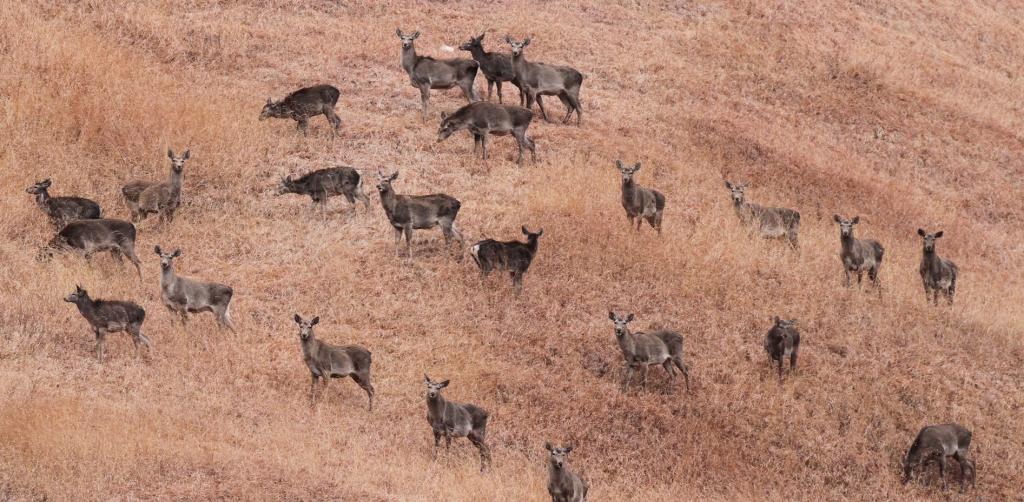
A massive decline in the population of Kashmir’s iconic wildlife species, the Hangul (Cervus hanglu hanglu), also known as the Kashmir stag, continues to be a big concern as conservation efforts for the deer, going on for years, have not yielded any significant results so far.
Today, the Hangul, the state animal of Jammu & Kashmir, is restricted to the Dachigam National Park some 15 km north-west of Jammu & Kashmir’s summer capital Srinagar.
From a population of 5,000 in the early 1900s, the Hangul’s numbers have constantly declined over the decades, making it largely confined to the 141 square kilometres of Dachigam National Park, although some studies suggest that small isolated Hangul herds of five to ten have been reported from adjoining areas of Dachigam which include Shikargah-Tral and the Overa-Aru Wildlife Sanctuary in south Kashmir.
The Hangul was once widely distributed in the mountains of Kashmir and parts of Chamba district in neighbouring Himachal Pradesh. But, now, the IUCN’s Red List has classified it as Critically Endangered and is similarly listed under the Species Recovery Programme of the Wildlife Institute of India (WII) and the Environmental Information System (ENVIS) of the Ministry of Environment, Forest and Climate Change (MoEF&CC).
The Hangul is considered equally significant to the state of Jammu & Kashmir as the tiger is to the whole of India. It is the only Asiatic survivor or sub-species of the European red deer. But the state animal’s decreasing population remains a big concern.
According to the latest survey in 2017, the population of Hangul is 182 in Dachigam and adjoining areas. Earlier population estimates suggest that there were 197 deer in 2004 and 186 in 2015. Results of the latest survey (2019 survey) being carried out presently are expected in a month or so. But experts don’t expect any positive change in the population growth of the Hangul.
The International Union for Conservation of Nature’s (IUCN) Red Data Book — which contains lists of species at risk of extinction — has declared the Hangul as one of three species that were critically endangered in Jammu and Kashmir. The other two are the Markhor — the world’s largest species of wild goat found in Kashmir and several regions of central Asia — and the Tibetan antelope or ‘Chiru’, found mostly in the mountainous regions of Mongolia and the Himalayas, where Jammu and Kashmir is mostly situated.
The Hangul is placed under Schedule I of the Indian Wildlife (Protection) Act, 1972 and the J&K Wildlife Protection Act, 1978.
The biggest challenges which have been identified by experts in the way of conservation and population growth of Hangul are habitat fragmentation, predation and very low fawn-female ratio.
Conservation measure taken by the wildlife department in recent years is a project for improving the population of the Hangul through ex-situ breeding. The breeding centre, along with some infrastructure over a five-acre forested area in south Kashmir’s Shikargah-Tral was started a few years ago. But wildlife officials say that so far, they have not come across any appropriate parental stock.
Kashmir’s regional wildlife warden, Rashid Naqash, told this writer last year that the wildlife department “is actually looking for young parental stock which can breed naturally in the habitat where we have created conducive conditions. But, since the animal is already under great stress, we are not trying to capture the animals forcibly.”
This year also, the department is waiting for the young parental stock to “venture accidentally” into that area. “Once the parental stock ventures there, it will find the area much more adaptable.” Naqash said.
Wildlife experts say that a strong political will, which can help putting total focus on the Hangul’s conservation, is still lacking though former chief ministers have given assurances about conservation of this flagship wildlife species.
Source:
https://www.downtoearth.org.in/blog/wildlife-biodiversity/kashmir-why-the-hangul-s-future-still-hangs-in-the-balance--64292